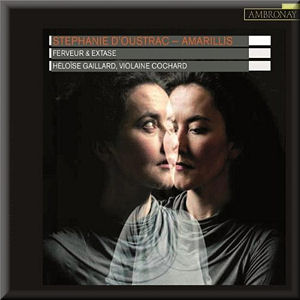 |
 |
| 

alternatively
CD:
MDT
AmazonUK
AmazonUS
|
Ferveur et Extase
Francesco CAVALLI (1602-1676)
Canzon [5:58]
La Didone (1641): Lamento di Didone [5:25]
Luigi ROSSI (c.1597-1663)
L'Orfeo: Les pleurs d'Orphée ayant perdu sa femme (Fantaisie) [1:49]
Alessandro SCARLATTI (1660-1725)
La Didone delirante:
sinfonia [2:15]
Se non di me del Regno, recit (II,7) [0:20]
Caro nome, aria (II,7) [2:53]
Ma la mente agitata, recit (II,7) [0:36]
Concerto for recorder, two violins and bc in F: grave [1:13]
Concerto VII for recorder, two violins and bc in D: allegro - adagio [2:07]
La Didone delirante:
Infelice e che miro - Furie, turbini dell'onde, recit, aria (III,11) [4:29]
Concerto IX for recorder, two violins and bc in a minor: largo - fuga [3:58]
Michelangelo FAGGIOLI (1666-1733)
Didone abbandonata da Enea, cantata a voce sola [7:06]
Andrea FALCONIERI (1585-1656)
Passacalle [4:20]
Barbara STROZZI (1619-c.1664)
O Maria [6:26]
Biagio MARINI (c.1587-1663)
Sinfonia primo tuono (from op. 22) [1:47]
Claudio MONTEVERDI (1567-1643)
Pianto della Madonna [7:25]
Biagio MARINI
Sinfonia sesto tuono (from op. 22) [0:59]
Henry PURCELL (1659-1695)
Dido and Aeneas: Thy hand, Belinda - When I am laid in earth, recit, aria [5:08]
 Stéphanie d'Oustrac (mezzo)
Stéphanie d'Oustrac (mezzo)
Amarillis/Héloïse Gaillard, Violaine Cochard
rec. 20-23 September 2010, Espace culturel C.J. Bonnet, chapel of Jujurieux, France. DDD
 AMBRONAY AMY027 [64:18]
AMBRONAY AMY027 [64:18]
|
|
|
One of the features of the baroque era is that sacred and secular
music are not strictly separated. Music which was first set
to a secular text could easily be used later for a sacred text,
without anyone taking offence. Moreover, stylistically there
often wasn't that much of a difference between the two genres.
Both aspects come to the fore in this programme.
The title, 'Fervour and ecstasy', reflects the character of
the vocal items. Two figures are at the centre: Dido and the
Virgin Mary. In her liner-notes Héloïse Gaillard writes: "The
voice of the Virgin and that of Queen Dido echo one another.
The latter's passionate love for Aeneas amd her desolation after
he has abandoned her is answered by Mary's fervour." This
has been the guide for the choice of music. The first part is
devoted to Dido. After a canzona by Francesco Cavalli we hear
the 'Lamento di Didone' from his opera La Didone. It
dates from 1641 and was only his third opera. That means that
it is stylistically close to the late operas of Monteverdi,
in which the principle of recitar cantando (speech-like
singing) still dominates. Fairly recently an opera on the same
subject by Alessandro Scarlatti has been rediscovered, La
Didone delirante, dating from 1696. Here we find the trademarks
of the style which had developed in the late 17th century, of
which Scarlatti was one of the forerunners: the division in
recitatives and arias. Two pairs of these have been selected,
which are interspersed by some movements from sonatas for recorder
and strings. This is motivated by the wish to "immerse
the listener more deeply in the affects of these arias".
Personally I find this decision rather unfortunate as it breaks
up the tension which has been built up. In the genre of the
chamber cantata the character of Dido also frequently appears.
Didone abbandonata da Enea by Franco Faggioli, like Scarlatti
a composer born in Naples, begins with a recitative: "O
deceptions, O betrayals! Stop, cruel Aeneas, stop and listen".
Like so many chamber cantatas of that time it comprises two
pairs of recitatives and arias. Surprisingly the title of this
cantata isn't mentioned in the track-list or the liner-notes.
The second part is about the Virgin Mary. The best-known piece
is Il pianto della Madonna by Claudio Monteverdi. It
is an example of music which was originally used for a secular
text, the 'Lamento d'Arianna' from his lost opera Arianna.
The version with a sacred text was printed in Monteverdi's large
collection of sacred music, Selva morale e spirituale,
of 1641. It is in every way as expressive and dramatic as its
secular predecessor. Mary expresses her sadness and despair
while seeing her son die on the cross: "Now let me die,
my son. For what mother can be comforted in this cruel sorrow,
in this torment so hard to bear?" Of a quite different
character is O Maria by Barbara Strozzi, the most famous
female composer of the 17th century. This is no lament; the
'fervour and ecstasy' are of a quite different kind here. It
is a piece which expresses a deep-felt and highly emotional
devotion to the Virgin Mary. Its first lines - which are repeated
after the two stanzas which follow - are telling: "O Mary,
how beautiful you are, how sweet, how comely, how beautiful
you are!" The difference with texts expressing secular
love is negligible.
The programme surprisingly ends with a piece by Purcell, the
famous lament of Dido from his opera Dido and Aeneas.
Its choice is odd considering that the other items of the programme
are by Italian composers. On the other hand, the Italian influence
on Purcell clearly comes to the fore here. Unfortunately it
is the least convincing item in the programme. I have heard
more dramatic accounts of this lament. I have no idea why a
recorder is used in the closing ritornello.
The Italian items are very well performed, though. In previous
recordings Stéphanie d'Oustrac has shown her dramatic qualities,
and they shine here again, also thanks to her strong low register.
She dives into the music and expresses the affects evocatively,
and meets the requirements of recitar cantando quite
well. She could have been a little more generous in her ornamentation.
The ensemble performs the instrumental items beautifully.
All in all, this is a fine disc with a nice mixture of more
or less familiar and hardly-known items.
Johan van Veen
http://www.musica-dei-donum.org
https://twitter.com/johanvanveen
|
|

